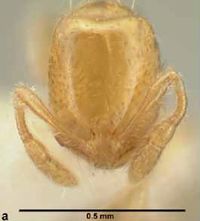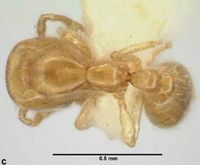Solenopsis cooperi
| Solenopsis cooperi | |
|---|---|

| |
| Scientific classification | |
| Kingdom: | Animalia |
| Phylum: | Arthropoda |
| Class: | Insecta |
| Order: | Hymenoptera |
| Family: | Formicidae |
| Subfamily: | Myrmicinae |
| Tribe: | Solenopsidini |
| Genus: | Solenopsis |
| Species: | S. cooperi |
| Binomial name | |
| Solenopsis cooperi Donisthorpe, 1947 | |
| Synonyms | |
| |
Solenopsis cooperi has remained little known since the description by Donisthorpe (1947) when only the gynes and males were collected from Siwa Oasis in the western desert (previously known as the Libyan Desert). It appears to be restricted to Egypt. During two field trips carried out by the first author to Saloga Island Protectorate (located in the River Nile in Aswan) and to Abu-Swelam village (El-Minyia Governorate, Upper Egypt), many workers, males and two alate gynes were collected. Very little is known of the biology of S. cooperi, except for the colony from which our specimens were collected. This colony was small and in loose sandy soil at the base of an old tree. (Sharaf et al. 2009)
Identification
Sharaf et al. (2009) - Newly collected specimens of Solenopsis cooperi match the rather short description of S. cooperi given by Donisthorpe (1947), i.e. notably being brown, smooth & shining, with pale yellow appendages.
The workers are readily distinguished from the known circum-Mediterranean species by the long peduncle to the petiole; the relatively high, narrowly rounded petiole profile; the proportionally longer head which is flattened in lateral view; and the angular, near dentate and longitudinally weakly furrowed propodeal dorsum.
Keys including this Species
- Key to Arabian Solenopsis
- Key to Solenopsis workers of Egypt
- Key to Solenopsis queens and males of Egypt
Distribution
Latitudinal Distribution Pattern
Latitudinal Range: 28.1° to 24.05°.
| North Temperate |
North Subtropical |
Tropical | South Subtropical |
South Temperate |
- Source: AntMaps
Distribution based on Regional Taxon Lists
Palaearctic Region: Egypt, Libya (type locality).
Distribution based on AntMaps
Distribution based on AntWeb specimens
Check data from AntWeb
Countries Occupied
| Number of countries occupied by this species based on AntWiki Regional Taxon Lists. In general, fewer countries occupied indicates a narrower range, while more countries indicates a more widespread species. |

|
Estimated Abundance
| Relative abundance based on number of AntMaps records per species (this species within the purple bar). Fewer records (to the left) indicates a less abundant/encountered species while more records (to the right) indicates more abundant/encountered species. |

|
Biology
Castes
Sharaf et al. (2009) - The workers examined could be divided into two size groups, suggesting dimorphism. Worker dimorphism has not been reported for Egyptian Solenopsis, but it is known for Solenopsis orbula from Corsica (Emery, 1916). Both major and minor workers were collected from a nest in association with gynes and males. Both groups of workers have a similar head shape, especially the flattened profile.
Worker

| |
| . | |
Queen
Images from AntWeb
    
| |
| Holotype of Solenopsis cooperi. Queen (alate/dealate). Specimen code casent0902334. Photographer Will Ericson, uploaded by California Academy of Sciences. | Owned by NHMUK, London, UK. |

| |
| . | |
Male

| |
| . | |
Nomenclature
The following information is derived from Barry Bolton's Online Catalogue of the Ants of the World.
- cooperi. Solenopsis cooperi Donisthorpe, 1947e: 110 (q.m.) EGYPT.
- Type-material: 8 syntype queens, 5 syntype males.
- Type-locality: Egypt: Siwa, 15.v.1935 and 24.v.1935 (J. Omer-Cooper).
- Type-depository: BMNH.
- Sharaf, Taylor & Klingenberg, 2009: 52 (w.).
- Status as species: Ettershank, 1966: 140; Bolton, 1995b: 387; Sharaf, Taylor & Klingenberg, 2009: 51 (redescription); Sharaf & Aldawood, 2011: 478 (in key); Sharaf & Aldawood, 2012: 18 (in key); Borowiec, L. 2014: 153.
- Senior synonym of bakri: Sharaf, Taylor & Klingenberg, 2009: 51.
- Distribution: Egypt.
- bakri. Solenopsis bakri Sharaf, in Fadl et al. 2007: 242, figs. 11-16 (w.q.m.) EGYPT.
- Type-material: 33syntype workers, 6 syntype queens, 8 syntype workers.
- Type-locality: Egypt: Aswan, Saloga Is, 24.05°N, 32.56°E, 2.v.2002 (M.R. Sharaf), 1 worker Egypt: Abu-Swelam (El-Minyia), 23.06°N, 30.45°E, 29.vi.2003 (M.R. Sharaf).
- Type-depositories: ASUC, EESC, MACG.
- Junior synonym of cooperi: Sharaf, Taylor & Klingenberg, 2009: 51.
Unless otherwise noted the text for the remainder of this section is reported from the publication that includes the original description.
Description
Worker
Sharaf et al. (2009) - TL 1.53–1.76, HL 0.41–0.56, HW 0.34–0.45, SL 0.25–0.35, EL 0.02, AL 0.42–0.62, PL 0.12–0.21, PW 0.12–0.17, PPL 0.10–0.14, PPW 0.08–0.17, SI 73–77, CI 80–83 (12 measured).
Minor. Head relatively long and narrow, with a distinctive narrow profile; CI ca. 78. Mandibles quite narrow with only moderate teeth, the apical tooth somewhat elongated. Clypeus with a weakly impressed anterior margin and distinct but not sharp carinae. Frontal lobes set quite far apart. Frontal notch distinct. SI ca. 80. Head smooth and shiny with very minute hair pits. Promesonotum with a smooth profile, anteriorly rounded but posteriorly flat. Metanotal groove distinct, quite shallow and continuous dorsally. Propodeum with a distinctive dorsal longitudinal impression and posteriorly terminating in angular corners. Propodeal spiracles vertically ovoid and facing posteriorly. Petiole anterior peduncle short and narrow; viewed from above this is quite distinct. Petiole node quite high and narrow. Body with relatively few scattered short hairs. Overall colour dusky yellow, with the posterior of the gaster darkened.
Major. Head smooth with widely scattered but distinct hair pits; CI ca. 80. Mandibles narrow. Clypeus with only a weakly impressed anterior margin and very weak carinae. Frontal lobes set moderately far apart. Scape with a narrow base broadening after the mid-point and widest at about the two-thirds point, SI ca. 70. Promesonotum profile smooth and uninterrupted, almost flat posterior to the anterior convex half of the pronotum. Metanotal groove distinctly impressed. Propodeum with a small circular spiracle. Petiole node quite low with a domed profile. Gaster distinctly lighter than rest of the body. Overall with sparse, fine, relatively short, erect hairs.
Queen
Sharaf et al. (2009) - Paratype. TL 4.0, HL 0.75, HW 0.55, SL 0.50, EL 0.15, AL 1.0, SI 91, CI 73 (1 measured).
Additional material: TL 4.50–4.75; HL 0.75; HW 0.57–0.60; SL 0.47–0.475; EL 0.17–0.20; AL 1.15; SI 78–83; CI 79 (2 measured).
The large ocelli are very distinctive compared to the other circum-Mediterranean species.
Male
Sharaf et al. (2009) - Paratypes. TL 3.0, HL 0.35–0.45, HW 0.40–0.45, SL 0.10, EL 0.25, AL 1.10–1.25, SI 22–25, CI 100–114 (3 measured).
TL 3.0–3.6, HL 0.45–0.50, HW 0.40–0.52, SL 0.075–0.20, EL 0.17–0.25, AL 1.05–1.22, SI 21–43, CI 89–104 (7 measured).
Type Material
Sharaf et al. (2009) - Holotype gyne and paratype gynes and males, EGYPT: Siwa, 15 & 24.v.1935 (J. Omer-Cooper) (The Natural History Museum) [examined].
References
- Borowiec, L. 2014. Catalogue of ants of Europe, the Mediterranean Basin and adjacent regions (Hymenoptera: Formicidae). Genus (Wroclaw) 25(1-2): 1-340.
- Donisthorpe, H. 1947f. Results of the Armstrong College Expedition to Siwa Oasis (Libyan Desert), 1935: A second list of the Formicidae (Hymenoptera). Bull. Soc. Fouad Ier Entomol. 31: 109-111.(page 110, queen, male described)
- Fadl H.H. ; Bakr,R.F.A ; Badawy R.M. and Sharaf M. R. (2007 ) Six new species of ants (Hymenoptera : Formicidae ) from Egypt. The second international conference of economic entomology (Entomological Society of Egypt), Cairo, Egypt, 8-11, December,(1): 235-249.
- Schifani, E., Nalini, E., Gentile, V., Alamanni, F., Ancona, C., Caria, M., Cillo, D., Bazzato, E. 2021. Ants of Sardinia: An updated checklist based on new faunistic, morphological and biogeographical notes. Redia 104, 21–35 (doi:10.19263/redia-104.21.03).
- Sharaf, M. R., B. Taylor and C. Klingenberg. 2009. Ants of the genus Solenopsis Westwood, 1840 (Hymenoptera: Formicidae) in Egypt with a description of the worker castes of S. cooperi Donisthorpe, 1947. Zootaxa. 2004:49-58. PDf
References based on Global Ant Biodiversity Informatics
- Bakr R. F. A., H. H. Fadl, R. M. Badawy, and M. R. Sharaf. 2007. Myrmecophile insects associated with some ant species (Hymenoptera : Formicidae )in Egypt. The second international conference of economic entomology (Entomological Society of Egypt) ,Cairo, Egypt, 8-11 December, (1): 205-233.
- Borowiec L. 2014. Catalogue of ants of Europe, the Mediterranean Basin and adjacent regions (Hymenoptera: Formicidae). Genus (Wroclaw) 25(1-2): 1-340.
- Donisthorpe H. 1947. Results of the Armstrong College Expedition to Siwa Oasis (Libyan Desert), 1935: A second list of the Formicidae (Hymenoptera). Bulletin de la Société Fouad Ier d'Entomologie 31: 109-111.
- Ettershank G. 1966. A generic revision of the world Myrmicinae related to Solenopsis and Pheidologeton (Hymenoptera: Formicidae). Aust. J. Zool. 14: 73-171.
- Fadl H., R. F. Bakr, and R. M. Badawy. 2007. Six new species of ants (Insecta: Hymenoptera: Formicidae) from Egypt. Proceedings of the 2nd International Conference of the Entomological Society of Egypt 2: 235-249.
- Fadl, H., R. F. Bakr, M. Bawady, and M. R. Sharaf. "Six new species of ants (Insecta: Hymenoptera: Formicidae) from Egypt." In Proceedings of the Second International Conference of Economic Entomology, 235-249. Vol. 1. Cairo: Entomological Society of Egypt, 2007.
- Sharaf M. R., B. Taylor, and C. Klingenberg. 2009. Ants of the genus Solenopsis Westwood, 1840 (Hymenoptera: Formicidae) in Egypt with a description of the worker castes of S. cooperi Donisthorpe, 1947. Zootaxa 2004: 49-58.
- Sharaf M. R., and A. S. Aldawood. 2012. Ants of the genus Solenopsis Westwood 1840 (Hymenoptera: Formicidae) in the Arabian Peninsula with description of a new species, Solenopsis elhawagryi. PLoS ONE 7(11): e49485. doi:10.1371/journal.pone.0049485
- Sharaf M.R., A.S. Aldawood. 2011. First occurrence of Solenopsis Westwood 1840 (Hymenoptera: Formicidae), in the kingdom of Saudi Arabia, with description of a new species S. saudiensis n. sp. Ann. soc. entomol. Fr. 47 (34) : 474-479.

